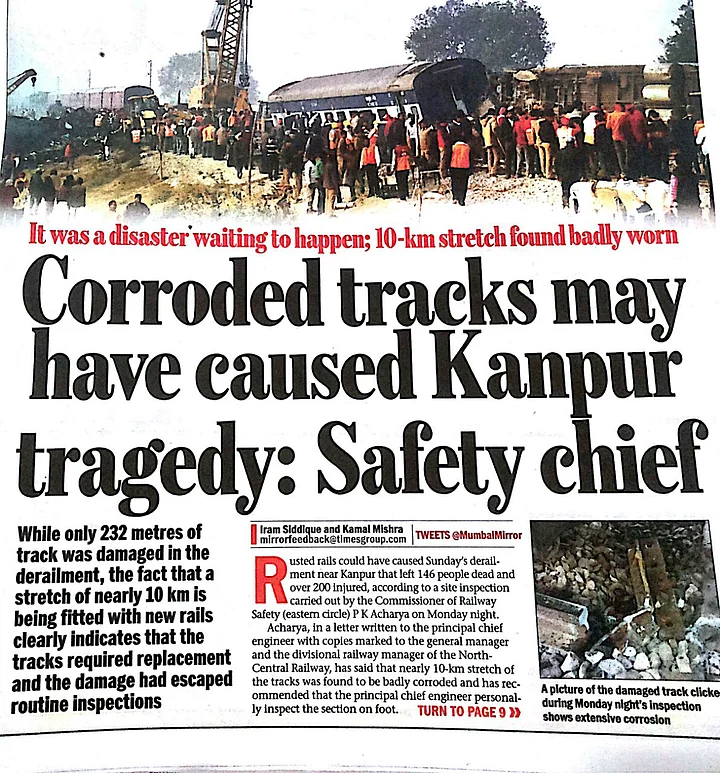In the wee hours of Sunday morning, 150 people (and counting) were killed when the Indore-Patna Express derailed. It’s the worst train accident in almost seven years after Maoists sabotaged the Gynaeshwari Express in West Bengal in May 2010, leaving 170 dead.
Railway Minister Suresh Prabhu has promised the strictest possible action against the guilty. But who really is to blame here? Was it sabotage by a handful of Maoists or did deliberate inaction by the Railway Ministry lead to these 150 deaths?
They Saw It Coming...
- The Indore-Patna Express tragedy is the worst in 7 years.
- Only 22 of 106 recommendations that predicted such accidents have been implemented in 4 years.
- Safer rail coaches can’t completely phase out the current ones until 2040.
- A request made by the Railways to the Finance Ministry for a Rs 1.2L crore sanction for a rail safety fund was denied.
- Rs 3,200 crore was allocated against the needed Rs 20,000-Rs 25,000 crore for the maintenance of existing rail infrastructure.
After the 2010 attack on the Gynaeshwari Express, a High Level Safety Review Committee was set up in 2011 under Dr Anil Kakodkar to ensure such a safety lapse is not allowed to occur again. They came up with a set of 106 recommendations in 2012, with a 2017 deadline to implement them.
One year before deadline, only 68 recommendations have been accepted – of which only 22 have been fully implemented. The rest are a work in progress, while some others have been rejected.
Dr Kakodkar Told Us So
Prima facie, the cause for Sunday’s derailment in Kanpur is a rail fracture. This is filed under “consequential rail accidents”, which also include sabotage, fire and collision as possible causes.
- 01/02After Day 1 of inspection, P K Acharya, Commissioner of Rail Safety, concluded that the section where the train derailed was heavily corroded and was up for renewal. (Photo courtesy: Picture of Mumbai Miror)

- 02/02The probable cause has thus been narrowed down to rail fracture due to corrosion. Picture of Mumbai Miror)

Rail fractures are the result of increased rail traffic on already laid down tracks at the end of their service lives. If the total tonnage (passenger trains, freight) carried surpasses the track’s capacity, there is an imminent danger of a rail fracture.
Statistics made available by the Railway Ministry show that in the last two years the focus has not been to strengthen the flaws in the system, but to initiate campaign-friendly policies.
Since coming to power, Suresh Prabhu has is also going to increase the average speed of passenger trains by 5km per hour and commission heavier 25-tonne axle load wagons on freight routes.
This, on the existing rotting infrastructure such as tracks, rolling stocks, signalling systems etc., by a government that has little or no money to renew or upgrade any of it any time soon.
When Lives Could Have Been Saved
During initial investigations in the Indore-Patna Express derailment, railway officials have confessed that the scale of the disaster could have been reduced greatly had stainless steel LHB coaches been used instead of the older ICF coaches.
While the ministry’s deadline is set at 2020 to fulfil this Kakodkar recommendation, various Railway officials contest that it simply is not possible before 2040. Apart from the usual red tape, all coach-making factories are filled with materials for ICF coaches. They’re worth crores, so they can’t be discarded and besides, the lifespan of the existing coaches is 25 years, so they can’t be discarded either.
Four years away from deadline, only 14 percent of all rolling stock constitute of LHB coaches. They are twice as expensive as regular ICF coaches, but the in-built safety features such as shock absorbers, disc-brakes, better coupling and anti-telescopic technology (they don’t turtle on derailment or collision) make it worth the price.
Show me the Money
While answering a question in the Lok Sabha in March this year, Minister of State, Manoj Sinha pegged the total cost of implementing the recommendations at Rs 1,11,683 crore under the Rashtriya Rail Sanraksha Kosh – a sanction denied by the Ministry of Finance, citing a lack of funds.
Not only is the Centre claiming to have no funds to ensure the safety of passengers, the Railway’s pockets aren’t very deep either.
Former Railway Minister Dinesh Trivedi recently shed light on the grave financial situation of the Indian Railways. Trivedi declared it to be on the verge of bankruptcy, losing up to Rs 25,000 crore annually with a depleted Depreciation Reserve Fund (DRF).
To simply maintain old assets, money needs to be allocated to the DRF, which needs approximately Rs 20,000 crore to Rs 25,000 crore annually, given the state of our existing infrastructure. In 2016-17, Suresh Prabhu only allotted Rs 3,200 crore to the DRF.
Not Another Statutory Enquiry, Please
The result has been criminal negligence with death and destruction to property – and yet another statutory enquiry, which will take months to commence and then some to conclude, is going to help no one. The report will be compiled by the same officials who are in charge of making sure such accidents don’t occur. To expect an unbiased, objective report from them when the government is complicit would be naive.
According to a White Paper released last year by Prabhu, 4,500 kms of track of the total 1,14,907 kilometers need to be renewed annually. But due to financial constraints, as of March 2016, 5,900 kms of track is up for renewal and the arrears are only accumulating.
Instead, a judicial probe should be ordered with co-operation from local and central police forces. Ideally, it should be a third-party agency like the NTSB in the US; but that is a Kakodkar committee recommendation that is currently “under consideration”– still.

.jpeg?auto=format%2Ccompress&fmt=webp&width=720)
